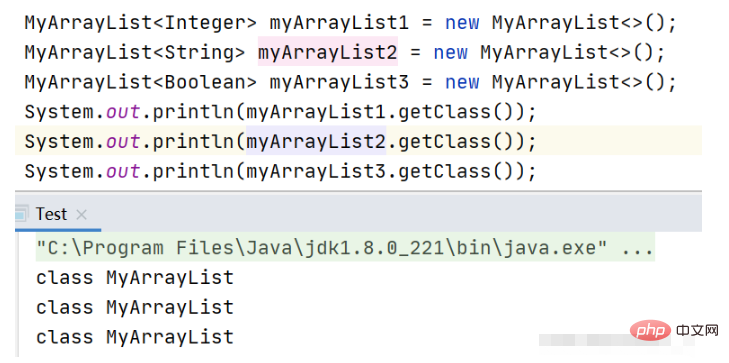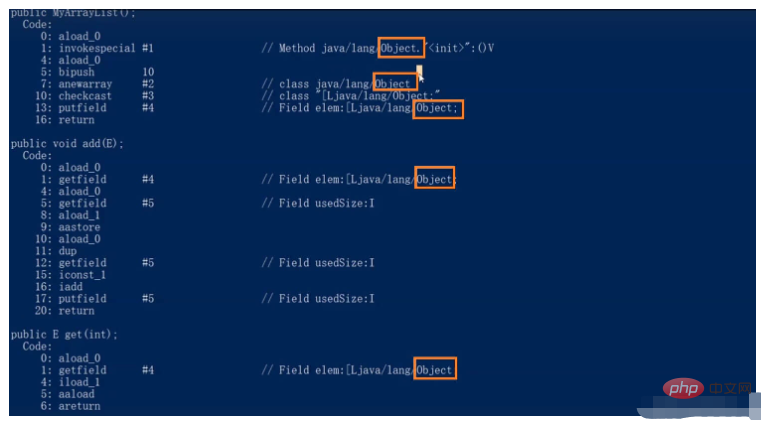Analysis of Getting Started with Java Generics
1. What are generics?
Generics actually means passing types as parameters. Generics allow programmers to use some types that are specified later when writing code. When instantiating the class, they will The desired types are passed as arguments to specify these types.
Why introduce generics?
For example: implement a sequence table by yourself
public class MyArrayList {
public int[] elem;
public int usedSize;
public MyArrayList() {
this.elem = new int[10];
}
// add方法
public void add(int val) {
// 暂时不考虑扩容问题,这里只是为了讲泛型
elem[usedSize++] = val;
}
// get方法
public int get(int pos) {
return elem[pos];
}
}It can be seen here that when using the above custom sequence table, we can only add int type elements. We know that in java collection Any type of data can be added to the sequence table. How is this achieved? Here we first try to change the int type into the Object type, so that we can guarantee that any type can be passed in.
public class MyArrayList {
public Object[] elem;
public int usedSize;
public MyArrayList() {
this.elem = new Object[10];
}
// add方法
public void add(Object val) {
// 暂时不考虑扩容问题,这里只是为了讲泛型
elem[usedSize++] = val;
}
// get方法
public Object get(int pos) {
return elem[pos];
}
}When adding data to the object in the main method, you can add any type of data. However, when data needs to be taken out, because the returned type is Object, forced conversion is required to receive it with the corresponding type, which is very troublesome.
public static void main(String[] args) {
MyArrayList myArrayList = new MyArrayList();
myArrayList.add(1);
myArrayList.add("hello");
int array1 = (int)myArrayList.get(0);
String array2 = (String)myArrayList.get(1);
}So the question is, does it have to be forced to be forwarded every time before it can be received? Can it be avoided? At this time, we thought that when creating an instance object, we can pass the desired type as a parameter, so that all the data of the passed type can be stored in this object. Then when we take it out, we can clearly identify all the data in the object. They are all of this type, no need to force transfer. This introduces generics.
public class MyArrayList<E> {
// 在编写程序时,不指定具体的类型,而用<E>这里的E来暂时代替
// 具体的类型在实例化对象时传入
public E[] elem;
public int usedSize;
public MyArrayList() {
// 这里的写法不是特别准确,应该用反射机制,这里先这样写
this.elem = (E[])new Object[10];
}
// add方法
public void add(E val) {
// 暂时不考虑扩容问题,这里只是为了讲泛型
elem[usedSize++] = val;
}
// get方法
public E get(int pos) {
return elem[pos];
}
}public static void main(String[] args) {
MyArrayList<Integer> myArrayList1 = new MyArrayList<>();
myArrayList1.add(1);
myArrayList1.add(3);
// myArrayList1.add("world");// 这里会报错,因为传入的数据不是指定的类型,所以泛型还有自动对类型进行检查的作用
int I1 = myArrayList1.get(0);
MyArrayList<String> myArrayList2 = new MyArrayList<>();
myArrayList2.add("hello");
myArrayList2.add("world");
String s1 = myArrayList2.get(0);
}This ensures that any type of data can be passed in, and there is no need to force it when taking it out! The meaning of generics:
1. Automatically check the type
2. Automatically perform forced type conversion
So what is the type of the corresponding object of MyArrayList here? Is it MyArrayList or something like that?

It can be seen here that the types of objects created by the instance are all MyArrayList, and the content in does not participate in the composition of generic types, then Where are the types inside? This requires understanding the working mechanism of generics.
2. How generics are compiled
An important difference between arrays and generics is how they enforce type checking. Specifically, arrays store and check type information at runtime. However, generics check for type errors at compile time and have no type information at runtime.
Generic compilation mechanism: erasure mechanism
During compilation, E in MyArrayList is erased into the Object type.

are all changed to MyArrayList type in the main method.

The above is the detailed content of Analysis of Getting Started with Java Generics. For more information, please follow other related articles on the PHP Chinese website!

Hot AI Tools

Undresser.AI Undress
AI-powered app for creating realistic nude photos

AI Clothes Remover
Online AI tool for removing clothes from photos.

Undress AI Tool
Undress images for free

Clothoff.io
AI clothes remover

AI Hentai Generator
Generate AI Hentai for free.

Hot Article

Hot Tools

Notepad++7.3.1
Easy-to-use and free code editor

SublimeText3 Chinese version
Chinese version, very easy to use

Zend Studio 13.0.1
Powerful PHP integrated development environment

Dreamweaver CS6
Visual web development tools

SublimeText3 Mac version
God-level code editing software (SublimeText3)

Hot Topics
 Square Root in Java
Aug 30, 2024 pm 04:26 PM
Square Root in Java
Aug 30, 2024 pm 04:26 PM
Guide to Square Root in Java. Here we discuss how Square Root works in Java with example and its code implementation respectively.
 Perfect Number in Java
Aug 30, 2024 pm 04:28 PM
Perfect Number in Java
Aug 30, 2024 pm 04:28 PM
Guide to Perfect Number in Java. Here we discuss the Definition, How to check Perfect number in Java?, examples with code implementation.
 Random Number Generator in Java
Aug 30, 2024 pm 04:27 PM
Random Number Generator in Java
Aug 30, 2024 pm 04:27 PM
Guide to Random Number Generator in Java. Here we discuss Functions in Java with examples and two different Generators with ther examples.
 Weka in Java
Aug 30, 2024 pm 04:28 PM
Weka in Java
Aug 30, 2024 pm 04:28 PM
Guide to Weka in Java. Here we discuss the Introduction, how to use weka java, the type of platform, and advantages with examples.
 Armstrong Number in Java
Aug 30, 2024 pm 04:26 PM
Armstrong Number in Java
Aug 30, 2024 pm 04:26 PM
Guide to the Armstrong Number in Java. Here we discuss an introduction to Armstrong's number in java along with some of the code.
 Smith Number in Java
Aug 30, 2024 pm 04:28 PM
Smith Number in Java
Aug 30, 2024 pm 04:28 PM
Guide to Smith Number in Java. Here we discuss the Definition, How to check smith number in Java? example with code implementation.
 Java Spring Interview Questions
Aug 30, 2024 pm 04:29 PM
Java Spring Interview Questions
Aug 30, 2024 pm 04:29 PM
In this article, we have kept the most asked Java Spring Interview Questions with their detailed answers. So that you can crack the interview.
 Break or return from Java 8 stream forEach?
Feb 07, 2025 pm 12:09 PM
Break or return from Java 8 stream forEach?
Feb 07, 2025 pm 12:09 PM
Java 8 introduces the Stream API, providing a powerful and expressive way to process data collections. However, a common question when using Stream is: How to break or return from a forEach operation? Traditional loops allow for early interruption or return, but Stream's forEach method does not directly support this method. This article will explain the reasons and explore alternative methods for implementing premature termination in Stream processing systems. Further reading: Java Stream API improvements Understand Stream forEach The forEach method is a terminal operation that performs one operation on each element in the Stream. Its design intention is






